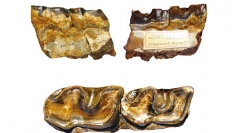

 Geodiversitas
35 (3) - Pages 629-641
Geodiversitas
35 (3) - Pages 629-641The present article is dealing with some rhinocerotid teeth from the Middle Miocene mammal locality Chryssavgi (CHR), which is situated in the Mygdonia Basin (Macedonia, Greece). The material was incorrectly described earlier as Diceros pachygnathus (Psarianos, 1958) or Dicerorhinus orientalis (Dimopoulos, 1972) and considered as Late Miocene to Early Pliocene in age. The morphological characters of the CHR rhinocerotid and its comparison with the Eurasian ones indicate that it belongs to Brachypotherium brachypus (Lartet, 1851). The correlation of the studied material to the local stratigraphy, as well as to the micromammalian fauna, found in CHR, suggests a Late Astaracian age, MN 7+8. The presence of the taxon in CHR corresponds to first occurrence of Brachypotherium Roger, 1904 in Greece from where was previously unknown. The geographic and biostratigraphic occurrence of B. brachypus in the Eastern Mediterranean region is also discussed. The species is quite common in Turkey but rare in the Balkans, known from the localities of Ahmatovo, Bulgaria and Chryssavgi, Greece. It mainly occurs in the Late Orleanian to Astaracian of Eastern Mediterranean but there is an evidence for its Turolian presence in Ahmatovo, Bulgaria.
Middle Miocene, Greece, Brachypotherium, description, biostratigraphy, biogeography